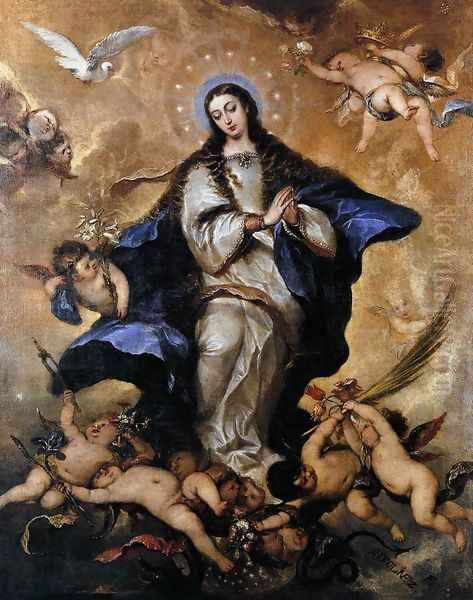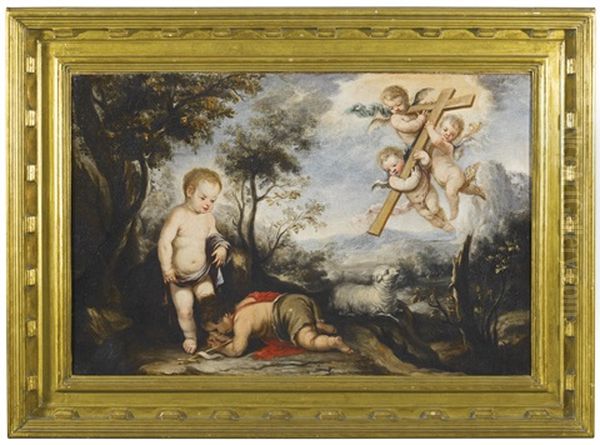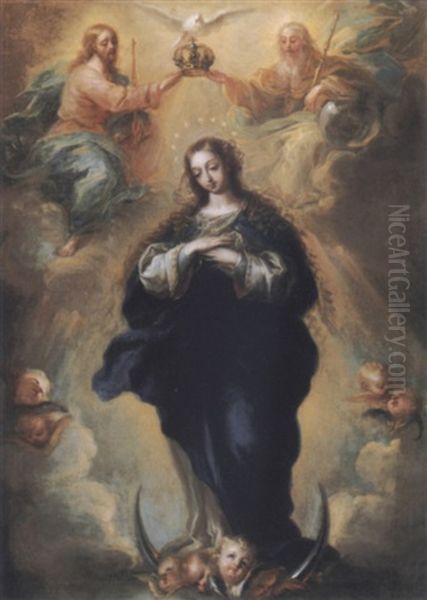José Antolínez stands as a significant, if sometimes underappreciated, figure in the rich tapestry of Spanish Baroque painting. Active during the latter half of the 17th century, a period often referred to as Spain's Golden Age (Siglo de Oro) in arts and letters, Antolínez carved out a distinct niche for himself, particularly within the bustling artistic environment of Madrid. Though his career was tragically cut short, his oeuvre demonstrates a remarkable talent, a keen understanding of color, and a dynamic approach to composition that set him apart from many of his contemporaries. His work, characterized by its vibrancy and technical skill, offers a fascinating window into the artistic currents and religious sensibilities of his time.
Early Life and Artistic Genesis in Seville
José Claudio Antolínez de Sarabia was born in Seville in 1635, a city that was then a major artistic and commercial hub in Spain. Baptized in the parish of Santos Justo y Pastor, he was the son of Antonio Antolínez, a craftsman skilled as a furniture maker and tailor, and María Antolínez (née de Sarabia). This familial background in craftsmanship might have instilled in young José an early appreciation for meticulous work and design, common among artists whose families were involved in artisanal trades.
Seville, during Antolínez's formative years, was a crucible of artistic innovation. It was the city of Francisco de Zurbarán, whose starkly realistic and spiritually intense works defined an earlier phase of the Baroque, and it was becoming the domain of Bartolomé Esteban Murillo, whose softer, more sentimental style would soon captivate audiences across Europe. It is within this vibrant Sevillian milieu that Antolínez likely received his initial artistic training. While details are somewhat scarce, it is believed he may have studied briefly with Ignacio de Yriarte, a notable Basque painter based in Seville who specialized in landscapes. This early exposure to landscape painting could have contributed to Antolínez's later proficiency in incorporating atmospheric and detailed backgrounds into his compositions.
The Move to Madrid and Training under Francisco Rizi

Seeking greater opportunities and exposure to the courtly art scene, Antolínez relocated to Madrid. This move was a common trajectory for ambitious provincial artists, as Madrid, being the capital, offered access to royal patronage, influential collectors, and a more diverse artistic community. In Madrid, Antolínez entered the prestigious workshop of Francisco Rizi. Rizi was a highly respected and influential figure in the Madrid school, known for his large-scale religious compositions, frescoes, and theatrical set designs. He was the son of an Italian painter, Antonio Ricci, who had come to Spain to work at El Escorial, and thus Francisco was well-versed in both Italian and Spanish artistic traditions.
Training under Rizi would have been transformative for Antolínez. Rizi's workshop was a dynamic environment where students learned not only the technical aspects of painting—drawing, color mixing, and composition—but also how to manage large commissions and work in a variety of formats. Rizi's own style, characterized by its fluid brushwork, rich coloring, and dramatic flair, heavily influenced by Venetian masters like Titian and Tintoretto, as well as Flemish painters like Peter Paul Rubens, undoubtedly left a significant mark on his pupil. Antolínez absorbed these lessons, developing a style that combined technical proficiency with a vibrant and expressive use of color.
Artistic Style: A Synthesis of Influences
Antolínez's mature style is a compelling fusion of various artistic currents, most notably the Venetian and Flemish schools, adapted to the specific tastes and religious context of 17th-century Spain. His paintings are often characterized by their luminous, rich colors, a hallmark of the Venetian tradition, particularly reminiscent of Titian and Paolo Veronese. He employed a colorito-driven approach, where color and light play a primary role in defining form and creating atmosphere, rather than a strict adherence to line (disegno).
From the Flemish school, particularly from masters like Rubens and Anthony van Dyck (whose works were known in Spain through originals and copies), Antolínez seems to have adopted a sense of dynamism, opulent textures, and a certain theatricality in his compositions. His figures are often energetic, caught in expressive poses, and his draperies are rendered with a lively, almost tactile quality. This is evident in the swirling movement of fabrics and the animated gestures of angels and saints that populate his religious scenes.
Unlike some of his Madrid contemporaries, such as Juan Carreño de Miranda, who often displayed a more Velázquez-influenced sobriety, Antolínez's work generally exudes a more overt decorative appeal and a brighter palette. His brushwork is typically free and confident, contributing to the overall vivacity of his canvases. He was particularly adept at creating complex, multi-figured compositions that are both well-ordered and visually exciting.
Master of the Immaculate Conception

One of the most recurrent and celebrated themes in Antolínez's oeuvre is the Immaculate Conception of the Virgin Mary. This doctrine, which held that Mary was conceived without original sin, was immensely popular in Spain, fiercely defended by theologians and passionately embraced by the populace. Artists were frequently commissioned to depict this subject, and Antolínez produced numerous versions, each showcasing his particular stylistic strengths. It is estimated he painted at least twenty-five variations on this theme.
His Immaculate Conceptions typically follow the established iconography: the Virgin, youthful and serene, stands on a crescent moon, often crushing a serpent (symbolizing her triumph over sin), surrounded by a celestial host of cherubic angels. What distinguishes Antolínez's interpretations is his vibrant use of color – particularly blues, pinks, and golds – and the dynamic arrangement of the figures. The angels are not mere accessories but active participants, their playful energy and varied poses adding to the scene's dynamism. The Virgin herself is often depicted with a gentle, sweet expression, her robes swirling around her in a manner that conveys both grace and movement. Notable examples of his Immaculate Conception can be found in museums such as the Prado Museum in Madrid, the Bilbao Fine Arts Museum, and the Ashmolean Museum in Oxford.
These works can be favorably compared to those by his contemporary Murillo, who was also a prolific painter of the Immaculate Conception. While Murillo's versions are renowned for their soft, vaporous sfumato and tender sentimentality, Antolínez's interpretations often possess a more robust energy and a brighter, more jewel-like palette, reflecting his Venetian and Flemish influences more directly.
Beyond Religious Themes: Portraits and Genre Scenes
While predominantly known for his religious paintings, Antolínez also demonstrated considerable skill in other genres, including portraiture and, to a lesser extent, genre-like or mythological scenes. His ability in portraiture is evident in works such as the "Portrait of a Man" or the group portrait he painted for the Danish ambassador to Madrid, Cornelius Pedersen Lerche, in 1662. This latter work, depicting the ambassador and his entourage, showcases Antolínez's capacity to handle complex compositions and capture individual likenesses within a formal setting.

There is also evidence of his engagement with mythological or allegorical subjects, such as "The Death of Lucretia" or "The Suicide of Cleopatra," themes popular in Baroque art for their dramatic potential and moral undertones. A particularly intriguing work is "The Painter's Dream" or "Allegory of Painting" (c. 1660, Museo de Bellas Artes de Sevilla), which depicts a sleeping artist, perhaps Antolínez himself, being inspired by an allegorical female figure representing Painting, surrounded by symbols of the arts and the transience of fame. This painting offers a glimpse into the artist's intellectual preoccupations and his place within the tradition of self-reflexive artistic commentary.
His skill in landscape, possibly nurtured during his early studies with Yriarte, is often evident in the backgrounds of his larger compositions, where he could create atmospheric depth and a sense of place. Some sources even laud him as a "second Titian" for his landscapes and portraits, a high compliment suggesting a mastery of color and naturalistic representation in these genres, though fewer pure landscapes by his hand are known today.
Personality, Anecdotes, and Unresolved Aspects
Biographical accounts, notably from the early art historian Antonio Palomino, paint Antolínez as a man of considerable talent but also of a somewhat difficult and vain temperament. Palomino describes him as witty and skilled, but also arrogant and prone to self-praise, which may have hindered his advancement in certain courtly or academic circles. He apparently attempted to pursue a career in law before fully committing to painting, suggesting a broad intellectual curiosity.
His deep religious faith is also noted, with records of his baptism and family connections to the church. Some accounts allude to profound religious experiences or moments of divine inspiration, which, while difficult to verify, align with the intense spiritual climate of Counter-Reformation Spain and the devotional nature of much of his work.
The evolution of his style, particularly in his depictions of the Madonna, has been a subject of discussion among art historians. Some scholars trace a development from an earlier, perhaps more rigid manner to the more fluid, dynamic, and colorful style of his mature works. This stylistic journey, occurring over a relatively short career, highlights his capacity for growth and absorption of diverse influences.
A poignant aspect of Antolínez's story is his early death in Madrid in 1675, at the age of only forty. This premature end undoubtedly curtailed a career that was still in its ascendancy. It is also believed that some of his works may have been left unfinished, with his nephew and possible pupil, Francisco Antolínez y Sarabia (who also became a painter, though of a more modest reputation), potentially completing some of them. This adds a layer of complexity to the attribution and study of his complete oeuvre.
Interactions with Contemporaries and the Madrid School
Antolínez was an active participant in the Madrid art scene, which, during his lifetime, was dominated by figures who had either worked with or were successors to the great Diego Velázquez, who died in 1660. Besides his teacher Francisco Rizi, other prominent painters in Madrid included Juan Carreño de Miranda, who succeeded Velázquez as court painter, and Claudio Coello, a younger artist who would become a leading figure in the late Baroque. Mateo Cerezo was another contemporary known for his rich color and dynamic compositions, sharing some stylistic affinities with Antolínez.
While Antolínez was not a direct pupil of Velázquez, the latter's influence permeated the Madrid school, particularly in terms of naturalism and painterly technique. However, Antolínez's style, with its more overt embrace of Venetian colorism and Flemish dynamism, offered a distinct alternative to the more restrained elegance often associated with Velázquez's direct followers.
His relationship with Murillo is one of comparison rather than direct collaboration, as Murillo was primarily based in Seville. However, their shared popularity in depicting themes like the Immaculate Conception invites stylistic comparison, highlighting the different regional interpretations and personal artistic choices within the broader Spanish Baroque. Antolínez's connection to Francisco Rizi was crucial, placing him within a lineage of artists who valued a rich, painterly approach. Rizi himself collaborated frequently with Carreño de Miranda, fostering an environment of artistic exchange in Madrid.
Legacy and Enduring Significance
Despite his relatively short life, José Antolínez left a significant body of work that enriches our understanding of the diversity and vibrancy of the Madrid school in the mid-17th century. He is considered one of the most accomplished colorists of his generation in Madrid, bringing a particular brilliance and energy to his canvases. His interpretations of the Immaculate Conception remain among the most visually appealing and dynamic of the period.
While perhaps not achieving the towering international fame of Velázquez or Murillo, Antolínez's paintings were highly esteemed in his time and continue to be valued for their technical skill, aesthetic appeal, and devotional sincerity. His work demonstrates how Spanish artists creatively synthesized international influences—particularly from Italy (Titian, Veronese, Tintoretto) and Flanders (Rubens, Van Dyck)—with local traditions and religious imperatives.
His influence can be seen in the work of his nephew, Francisco Antolínez y Sarabia, and he contributed to the overall richness of the late Baroque style in Madrid, which would continue with artists like Claudio Coello. Today, his paintings are held in major museums worldwide, allowing contemporary audiences to appreciate the talent of this "luminary of the Spanish Baroque." He remains a testament to the artistic vitality of Spain's Golden Age, a painter whose passionate use of color and dynamic compositions continue to captivate and inspire. His premature death undoubtedly left a void, but the works he did create secure his place as an important artist of his era.